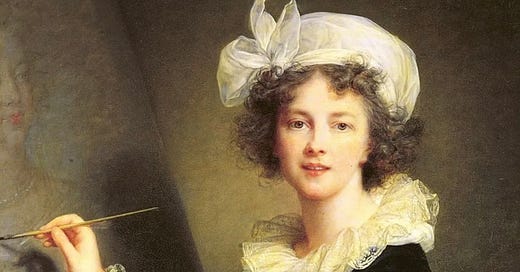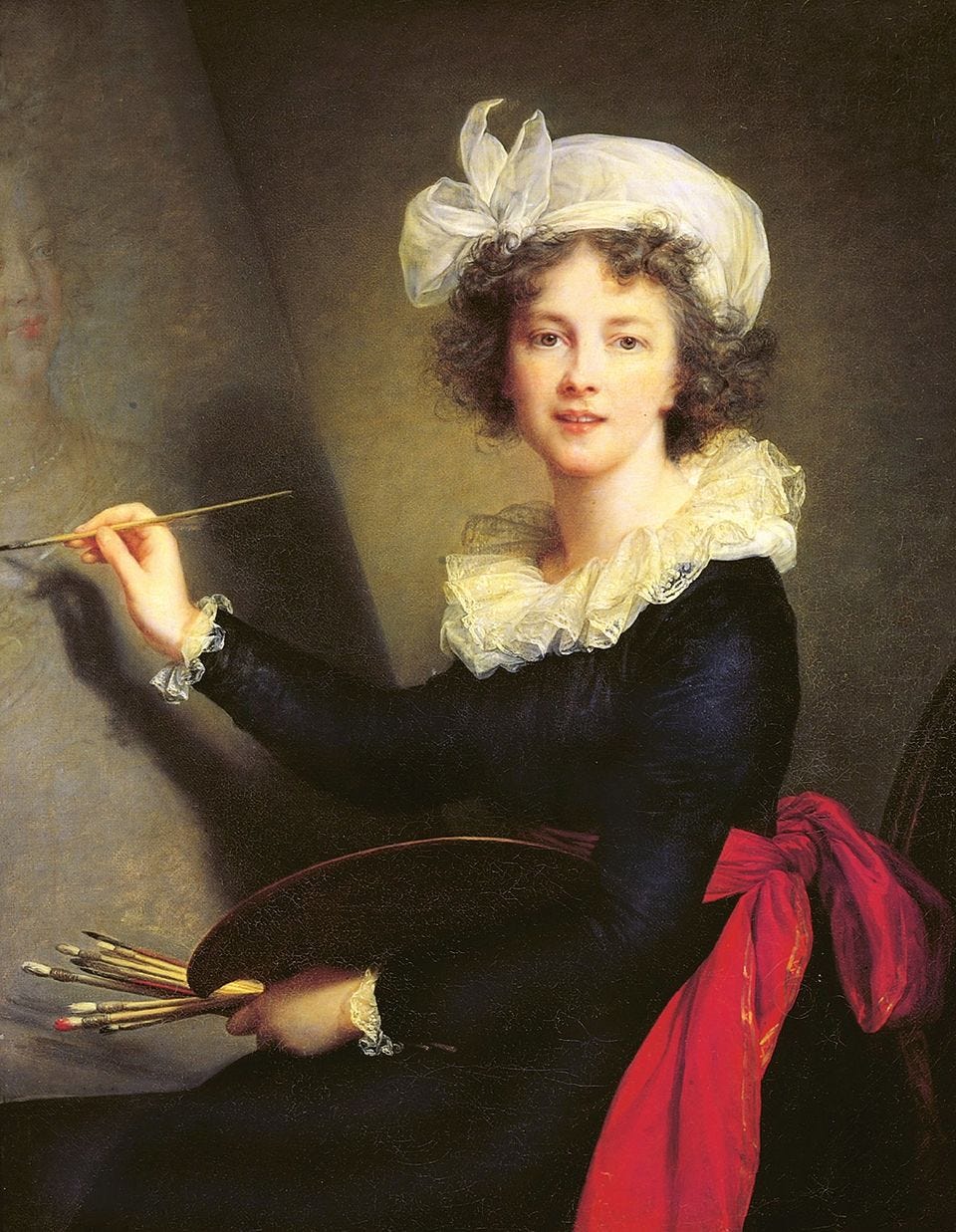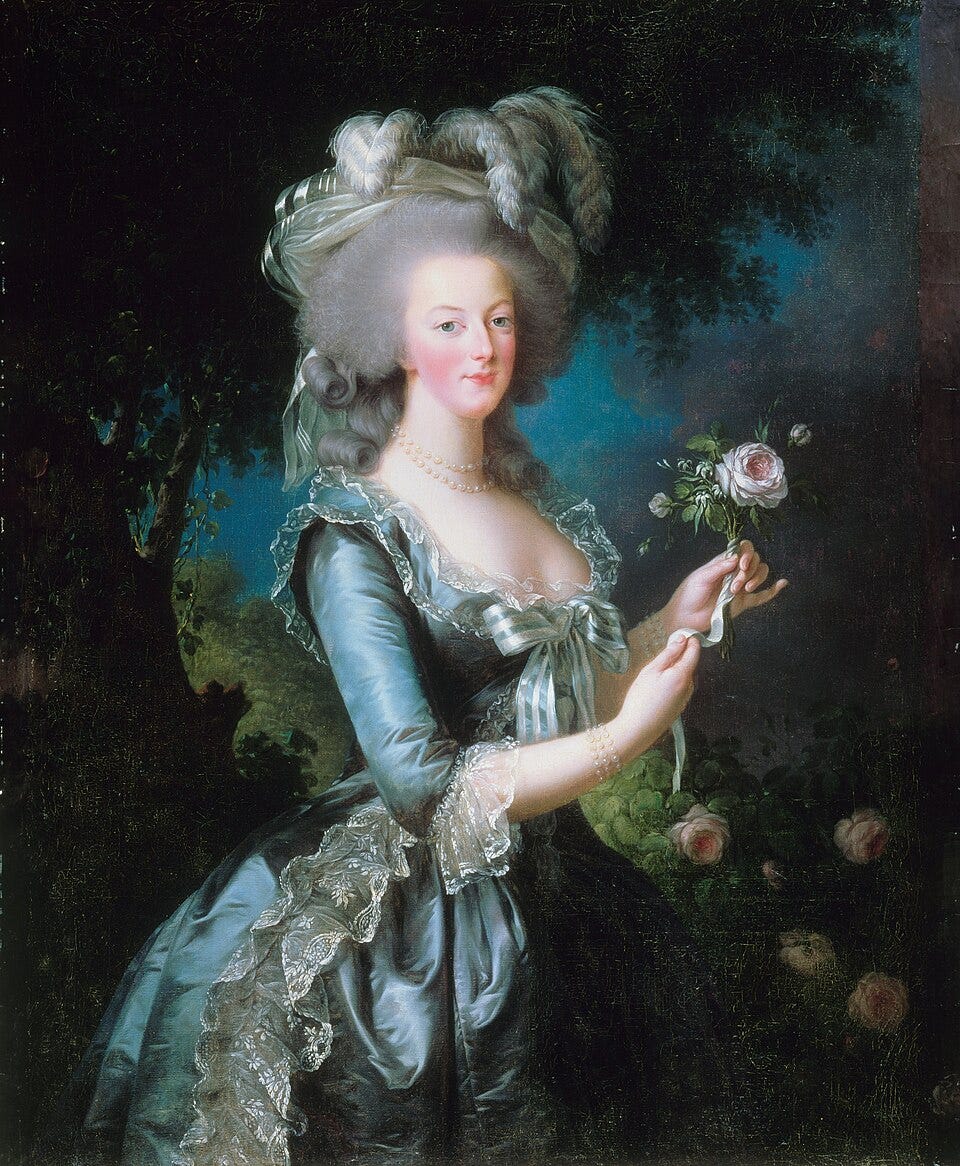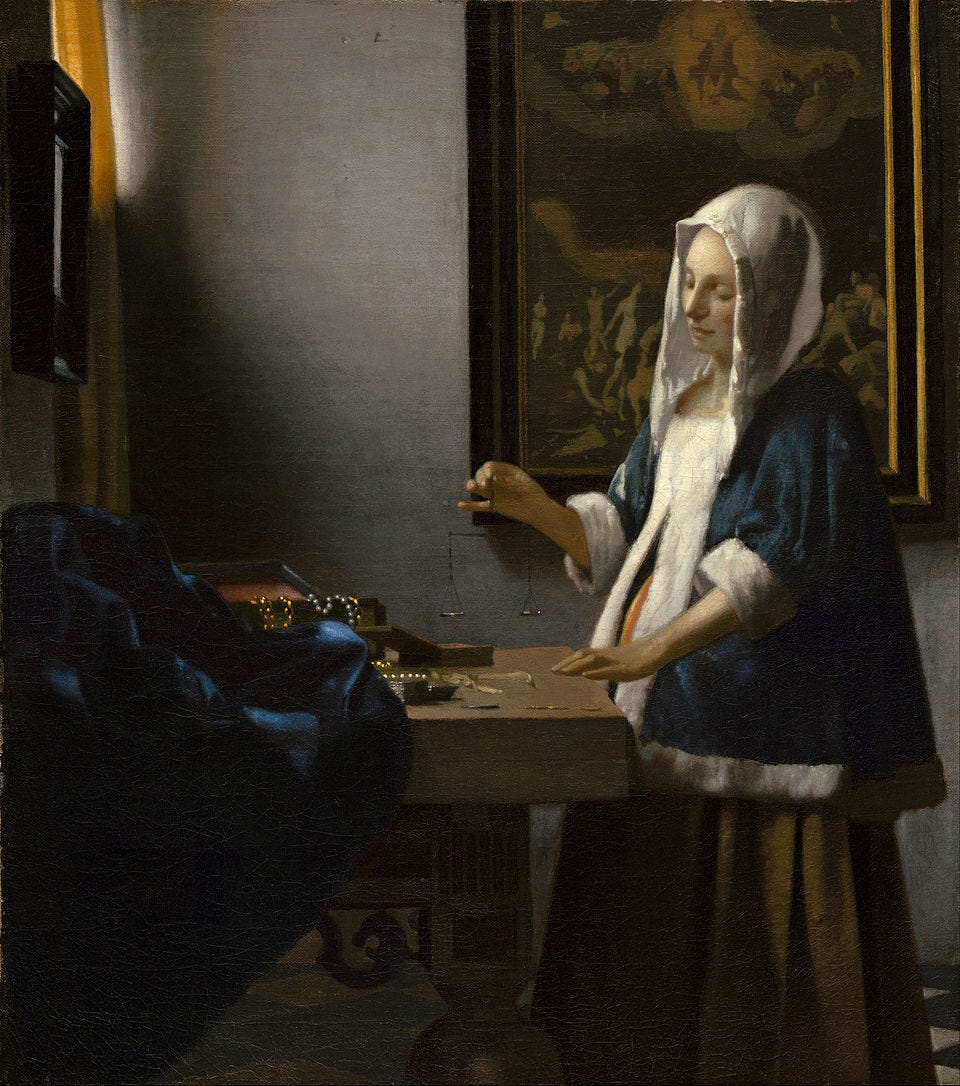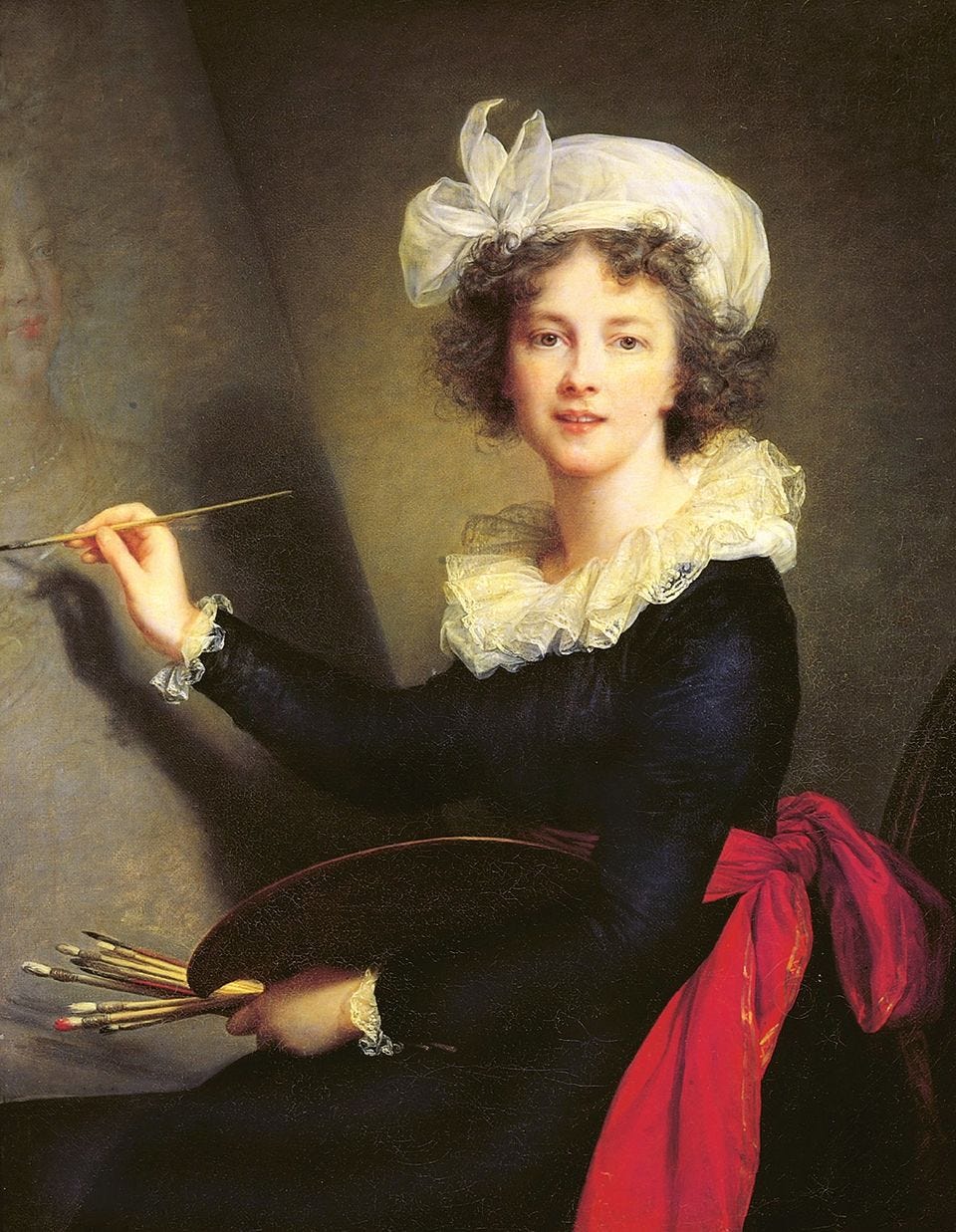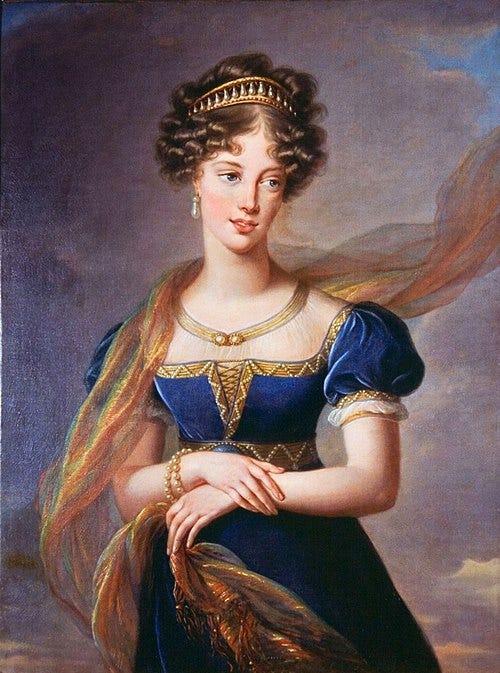The "French" Art of the Comeback, Pt. V: Élisabeth Vigée Le Brun
Florida Man explores the comeback of one of the most prominent female painters of French history
I have just completed my three essays exploring the career of Jacques-Louis David in three different periods.
As a court painter for King Louis XVI
As a propagandistic painter for Maximilien Robespierre during the French Revolution
As a propagandistic painter for Napoleon Bonaparte
Today, I continue the series of “The French Art of the Comeback” with Élisabeth Vigée Le Brun, one of the early prominent women in art history, but she does not have the same deep, complicated career that Jacques-Louis David had. For this reason, I will likely only need one essay to analyze her career. I will likely finish my series of painters with Jean-Auguste-Dominique Ingres, someone who similarly does not have as complicated of a career as Jacques-Louis David.
Le Brun’s Early Career as Marie Antoinette’s Portraitist
I want to analyze Le Brun through the lens of comparing and contrasting her with David. In many ways, they demonstrate two alternate paths of a comeback. They began in similar positions as painters for the royal court, but their universes diverged with the French Revolution. They took opposite positions at the beginning of the French Revolution.
David received his formal education at the Académie royale de peinture et de sculpture (or “Royal Academy of Painting and Sculpture”) as did most prominent artists in France at the time, but Le Brun did not. Le Brun could not receive her education there because it prohibited women, so she educated herself in an unorthodox, non-traditional manner. She began as a portraitist for members of the Ancién Regime.
Because of this work, the royal court hired her as the official portraitist of Queen Marie Antoinette, wife of King Louis XVI. Le Brun began painting for Marie Antoinette in 1778 at the age of 23 years old. Le Brun’s rise to prominence as a royal portraitist as a woman demonstrates her immense talent as a painter because of the discrimination and stigmas against female artists in France at the time. France didn’t have any affirmative action for female artists!
The image above shows Elisabeth Vigée Le Brun’s 1783 painting Marie Antoinette with a Rose, probably her most notable portrait of Marie Antoinette. Le Brun painted in the Rococo style with great delicacy and grace. We can describe this painting as feminine. Elisabeth Vigée Le Brun, a woman, was painting another elegant woman, Queen Marie Antoinette.
The painting includes feminine symbology, most notably the rose that Marie Antoinette is holding. Again, Marie Antoinette is holding this feminine flower with delicacy. After all, the flower functions as the female sexual organ of any plant. It receives the male pollen, which contains sperm cells that fertilize the female organ of the plant. Sure, most flowers include the male organ of the stamen, but — in art — we view the flower as the female embodiment of a plant. We especially view the rose as feminine, perhaps more so than any other type of flower. The color pink, seen in Marie Antoinette’s rose, represents femininity although we most commonly see red roses.
The delicacy with which Marie Antoinette holds the flower evokes how Dutch Golden Age painter Johannes Vermeer depicted female subjects. The painting above exemplifies how Vermeer achieved visual delicacy with female subjects in his works. The image above shows Vermeer’s 1663 painting A Woman Holding a Balance. The work depicts a woman literally holding a balance to weigh pearls. She is holding the balance with the same delicacy that Marie Antoinette holds the rose. They even hold each object in the same manner with their pinky fingers outward.
As Northern European painters did — as opposed to the more ornate painters of the Italian Renaissance and Italian Baroque periods — Johannes Vermeer painted this work with much more subtlety. He included much more Christian themes in his works than Le Brun would have done in her royal portraits. Without clearly conspicuous and overt images of Jesus Christ or the Virgin Mary as the Italians would paint, Johannes Vermeer depicts deeply Christian themes just with the balance, which symbolizes God weighing our souls as we enter Heaven or Hell in the Last Judgment. Johannes Vermeer’s painting A Woman Holding a Balance still depicts Christ but not as a focal point. Behind the woman, Johannes Vermeer includes a painting of the Last Judgment, the allusion that Vermeer is making with the balance. Nevertheless, one could argue that Le Brun is including Christian themes in Marie Antoinette. The rose evokes the imagery of the roses seen in the story of the Virgin of Guadalupe in Mexico.
This portrait of Marie Antoinette also demonstrates the French royalty trying to appeal to the educated classes, who would ultimately lead the French Revolution. Marie Antoinette is wearing a chemise, a more casual type of clothing, instead of royal regalia. With this official portrait, Le Brun wants to portray Marie Antoinette as more similar to the non-royals.
Fall During the French Revolution
Le Brun diverged from David at the beginning of the French Revolution. David could sense that the French royalty was losing momentum, so he joined forces with Robespierre and those leading the French Revolution. Le Brun similarly could detect that the French royalty was losing momentum, but she did not join the revolutionaries as David chose to do. Instead, she fled to Italy on October 5, 1789. The revolutionaries stormed the Bastille approximately three months earlier in July.
Le Brun escaped France at the perfect moment because the Women’s March on Versailles occurred on October 6, 1789. Working-class women marched twelve miles from Paris to Versailles because of the shortage of bread. They killed two royal guards once they arrived at Versailles. In response to the Women’s March, the royal family moved from the Palace at Versailles to Tuileries Palace in Paris so that the revolutionaries could surveil them more easily.
Due to her direct connection to the royal family, Elisabeth Vigée Le Brun feared that the revolutionaries would arrest her. If she had fled later in the French Revolution, then Robespierre could have easily chosen to guillotine her amid the Reign of Terror. Le Brun lived in three different countries during her self-exile from France:
Italy (1789-1792)
Austria (1792-1795)
Russia (1795-1801)
These places very much appreciated the French royalty. Marie Antoinette initially hailed from Austria and came from the Habsburg family. Her brother Joseph II was Archduke of Austria and Holy Roman Emperor. Marie Antoinette’s sister Maria Carolina married King Ferdinand IV of Naples and became Queen of Naples and Sicily. The Bourbons and Habsburgs dominated many of the royal courts in the states of Italy. Most of them opposed the French Revolution. In these countries, Elisabeth Vigée Le Brun continued her career by painting many royals and nobles.
I already showed this self-portrait of Elisabeth Vigée Le Brun at the beginning of the article. Le Brun made this painting during her time in Italy. She is maintaining the Rococo style, associated with French royalty. Even though Le Brun had left France, she was still referencing her connection to the French royalty in this self-portrait. She is painting a portrait of Marie Antoinette in the painting itself. This self-portrait also has a great amount of realism to it as Le Brun is depicting what she would actually be doing if she were painting. She is referencing her identity as a female portraitist in this piece. She is implicitly defending the very unpopular royalty in France by depicting herself painting Marie Antoinette in the work.
Three years later, amid the height of the Reign of Terror, Maximilien Robespierre guillotined both King Louis XVI and Queen Marie Antoinette. From the perspective of self-preservation, Elisabeth Vigée Le Brun made the correct choice in fleeing France for Italy. If she had stayed, Maximilien Robespierre would have likely killed her too. To survive, she would have had to follow David and align herself with Robespierre and the revolutionaries.
Le Brun’s Comeback in France
In 1792, the revolutionaries declared her as émigré. The émigré could not return to France, but — after the rise of Napoleon Bonaparte in 1799 — she came off the list in 1802. She could finally return to France. She began painting again, but she began painting surviving nobles in France under private commission. Unlike Jacques-Louis David, she never began painting for the new man in power — Napoleon Bonaparte — despite her history of painting for royalty.
After the fall of Napoleon I and the Bourbon Restoration in 1815, the political tides turned even more in Le Brun’s favor. She began painting Bourbons again. In 1824, she painted the portrait above of Marie-Caroline, the Duchess of Berry. Marie-Caroline was a member of the Bourbon family reigning in France. Le Brun lasted longer than David did, and she never changed her loyalties. She always stuck with the Bourbons whereas David switched from the Bourbons to Robespierre to Napoleon.
In 1835, at age 80, Elisabeth Vigée Le Brun published her memoirs. The fact that she could publish these works so late in her life cemented her as a survivor of the turbulent history of France. She did not die in exile as Napoleon and David did. Even though the Bourbons fell in France for the final time in 1830 in the July Revolution, the July Monarchy under Louis Philippe I — the Citizen King — never persecuted her. Rather, Elisabeth Vigée Le Brun died gracefully with a great artistic reputation at 86 years old in 1842. Both she and David embody the French Art of the Comeback, but they do so in two very different manners.


